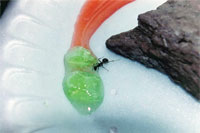Go Easy on the Ants

|
Good advice to everyone but an anteater. Wedged between last month’s ASIS International event with all of its technology dazzle and this month’s International Association of Chiefs of Police (IACP) conference in Chicago, got me thinking of the people side of risk management and crime fighting.
It was ASIS’s 57th big tent show. At the first fest in 1954, the average home was $10,250 and, that year, President Dwight Eisenhower signed into law the new Social Security bill funded by employers and employees. In addition, America at that time conducted a large scale, nationwide civil defense drill simulating the death of more than 12 million Americans in a mock nuclear attack.
Take the ant trail to today, with thousands of homes under water, Congress considering debt challenges in part due to Baby Boomers’ retirements and a worldwide worry over nuclear threats from North Korea, Pakistan to Iran.
And the first ASIS event is a young punk compared to the chiefs of police first get-together back in 1893. That year, the U.S. Marines invaded Hawaii; the New York Stock Exchange crashed into a depression; and the Lizzie Borden jury acquitted her of murdering her parents.
Things change; nothing really changes.
So should we be concerned about the ants? No doubt, there are anteaters out there. But, it seems from the statistics, surveys, polls, and studies, people, businesses and government agencies are safer and more secure today as compared to the 1890s or 1950s. Even in the face of a very challenging economy. It turns out that, as opposed to those who predicted an increase in crime and losses as the economy fell apart and unemployment exploded, street crime, white collar crime, and even shoplifting incidents have not increased measurably, according to the FBI Uniform Crime Report, the Justice Statistics Victimization studyand various retail crime studies.
Fine Focus on the Business
That’s thanks to increased focus on risk management, increased use of security technologies for deterrence and forensics and more carefully thought out policies and procedures.
For the ASIS types, the shift, I believe, came when security professionals identified more with their business than their specialty. When I first interviewed security directors in the early 1980s, for example, the person at the Widget Hospital would say he was a security professional working at a healthcare facility. Today, these good folks say they are healthcare professionals with a focus on security and life safety. For the IACP types, over the years they have become politically and community savvy as they shifted from peace of mind to quality of life.
Of course, the tragedy of 9/11 has stirred up the ant hill.
The mission of the FBI, for one, has changed significantly from a law enforcement agency to a domestic intelligence organization that is more proactive to deter incidents and illegal events.
Agents are now more involved in what the FBI labels “assessments,” which can range from preliminary to full investigations before there are criminal charges. It is speculated that the FBI will soon distribute a new “rulebook,” which will redefine preliminary assessments and the measures agents can do to collect information in an effort to move the investigation higher.
As with corporate security, the FBI is shifting to a proactive posture.
And it is ironic but good news as compared to its roots. The agency started out in 1886, when the Supreme Court, in Wabash, St. Louis & Pacific Railway Company v. Illinois, found that the states had no power to regulate interstate commerce. The resulting Interstate Commerce Act of 1887 created a Federal responsibility for interstate law enforcement. The Justice Department made little effort to relieve its staff shortage until the turn of the century, when Attorney General Charles Joseph Bonaparte reached out to other agencies, including the Secret Service, for investigators.
History of the FBI
But Congress forbade this use of Treasury employees by Justice, passing a law to that effect in 1908. So the Attorney General moved to organize a formal Bureau of Investigation, complete with its own staff of special agents. The first FBI agents were actually Secret Service agents. A first official task was visiting and making surveys of the houses of prostitution in preparation for enforcing the “White Slave Traffic Act,” or Mann Act. In 1932, it was renamed the United States Bureau of Investigation. The following year it was linked to the Bureau of Prohibition and rechristened the Division of Investigation before finally becoming an independent service within the Department of Justice in 1935. In the same year, its name was officially changed from the Division of Investigation to the present-day Federal Bureau of Investigation, or FBI.
With the current adjustment in focus for federal law enforcement to proactive, that anteater may have a feast on those ants.
Looking for a reprint of this article?
From high-res PDFs to custom plaques, order your copy today!




